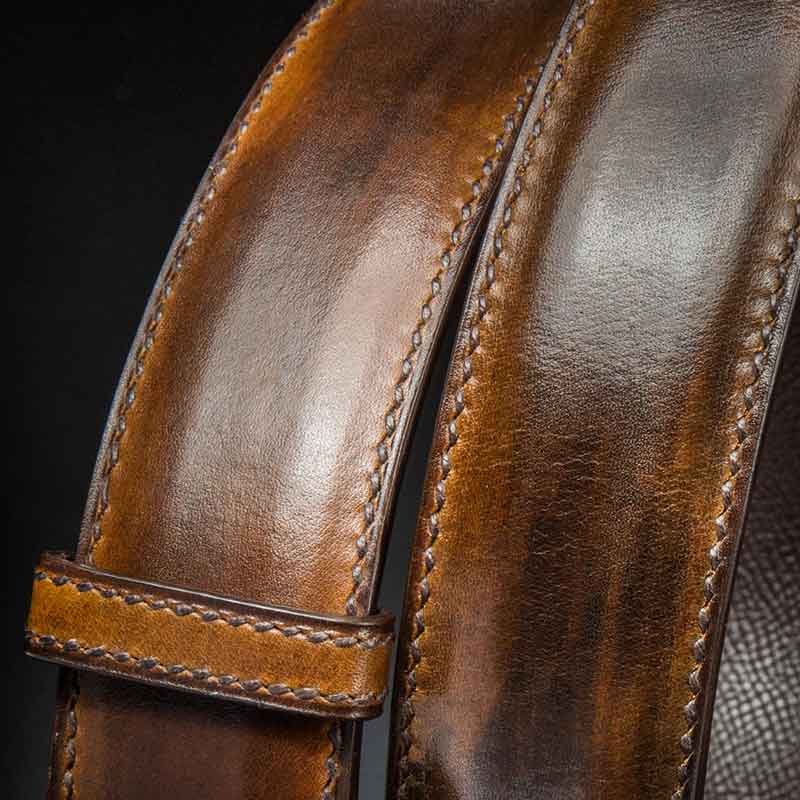Mastering Patina: An Indispensable Technique for Timeless Leather Creations

French leather craftsmanship is renowned worldwide for its unparalleled artisanal expertise, where each piece tells a story, marked by precision and excellence. Among the techniques that embody this mastery, patina holds a special place. Often unfamiliar to the general public, this subtle technique involves working the surface of the leather to reveal its depth and unique character. Today, as consumers increasingly seek personalised and sustainable creations, patina offers a modern answer to the market’s aesthetic and functional demands. This article invites you to explore the art of patina, a true fusion of tradition and innovation, which continues to captivate both creators and connoisseurs of exceptional leather goods.
What is patina in Leathercraft ?
In the world of leathercraft, patina refers to the process by which leather acquires a unique appearance, whether through natural ageing or the artisan’s intervention. As leather ages, it transforms: its colour subtly changes, its texture becomes richer, and it tells a story through its marks and nuances. However, patina is not limited to this natural evolution. Many leather artisans use specific techniques to enhance this effect, giving each piece an even more personalised character. Through the careful application of dyes, waxes, and polishing, the artisan can manipulate the colour, depth, and sheen of the leather, thus creating a bespoke work that highlights the raw material while meeting the client’s aesthetic expectations.

The different types of patina.
There are several types of patina in leathercraft, each adding a unique dimension to leather creations.
Natural patina develops over time as leather ages organically under the influence of air, light, and daily use. This type of patina gives leather an authentic, vintage appearance, highly sought after by those who appreciate products that tell a story.
In contrast, artisan patina is the result of the artisan’s meticulous work, enhancing the leather with personalised and refined nuances. Leatherworkers use techniques such as layering dyes, applying coloured waxes, and hand polishing to create effects like gradients, marbling, or gloss.
Finally, contemporary patina stands out for its boldness and originality, featuring vibrant colours and striking contrasts that cater to current fashion trends. Whether subtle or eye-catching, each type of patina imparts a unique character to the leather, while showcasing the artisan’s craftsmanship.


The process of creating an artisan patina.
Crafting an artisan patina is a complex process that requires both skill and patience. It all begins with the meticulous selection of leather, a crucial step as the quality and nature of the hide directly influence the final result. Once the leather is chosen, the artisan prepares the surface by cleaning and softening the material, making it ready to receive the various layers of dyes and treatments.
The patina process then involves the gradual application of dyes, often derived from natural pigments, which are applied by hand, using a brush or sponge. Each layer of dye is carefully spread and left to dry, allowing the leather to gradually absorb the colours. This step is essential in achieving deep, harmonious shades. After dyeing, specific waxes and creams are applied to nourish the leather, enhance its shine, and bring out the play of light. Finally, the leather is meticulously polished to reveal the full beauty of the patina. This entirely hand-crafted process gives the leather a unique artistic dimension, with each piece becoming a personalised work of art.
Why is patina trending ?
Patina is experiencing a resurgence in popularity, largely due to the changing expectations of consumers, who seek products that are both unique and durable. In a world increasingly dominated by mass production, patina stands out for its artisanal and personalised nature. Each patinated piece tells a story, and this uniqueness is particularly appealing to enthusiasts of luxury leather goods and bespoke creations.
Moreover, patina aligns with a broader trend towards authentic materials and traditional techniques, while offering endless creative possibilities. Brands and designers are leveraging this technique to create items that never go out of style and age with grace, reinforcing the idea that beauty lies in imperfections and the marks of time. This pursuit of authenticity, combined with a growing awareness of sustainability, makes patina a key element in the world of fashion and leathercraft, where aesthetics meet responsibility.

Patina, beyond being a simple aesthetic technique, embodies the very essence of leather craftsmanship. It is the tangible proof of the expertise and passion that lie behind each piece, where time, skill, and material merge to give birth to unique creations. For an artisan like Mickaël Benarroch, who champions excellence and quality at every stage of his work, patina is not merely a trend. It is the ultimate expression of leather mastery, a way to enhance this living material while respecting its integrity and history.
To offer hand-patinated creations is to give clients more than just a product: it is to share a vision. A vision of craftsmanship passed down through generations, where every imperfection becomes a testament to the encounter between artisan and material. In a world where handmade work is becoming rarer, Duret Paris stands out for its dedication to tradition, while addressing contemporary aspirations for authenticity and sustainability. Its purist approach to leathercraft, combined with a relentless pursuit of perfection, makes patina a signature, a promise of timeless quality.
